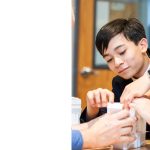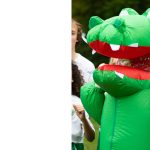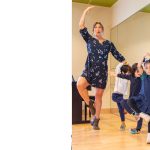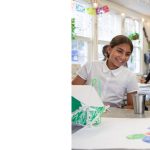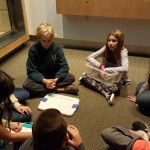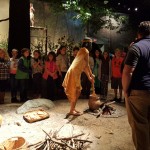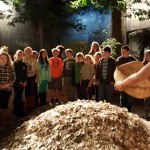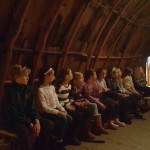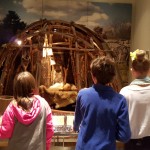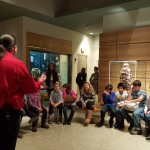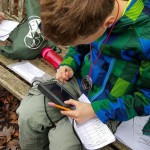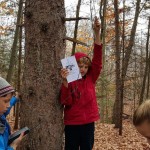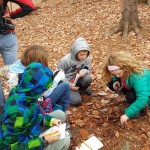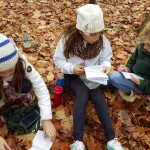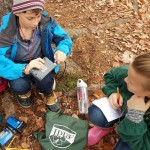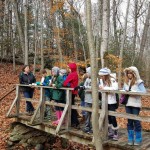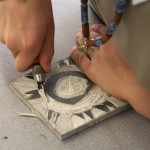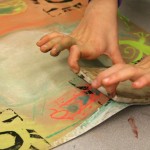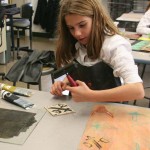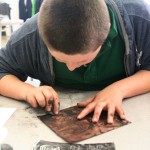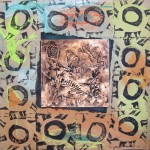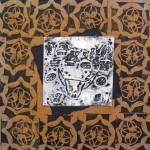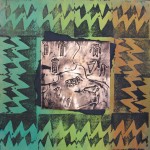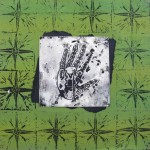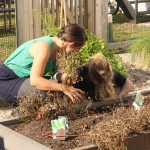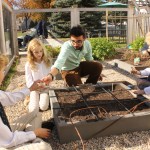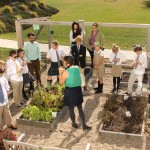¡Cómo vuela el tiempo!
Posted by Katie BrennaTo help fifth grade students review telling time in Spanish we played a game that I like to call “Time Flies.” Two student competitors were each equipped with a fly swatter and positioned in front of many different clock faces depicting various times. As a time was announced in Spanish, students searched and swatted the time that matched what they were hearing. As class drew to an end, student participants commented, “Class is over already?!?” How could I resist saying, “My how time flies when you’re playing Time Flies!”
A Step Back In Time
Posted by Mary FaulknerThe fifth grade class visited the Mashantucket Pequot Museum and Research Center. While there, they attended a workshop where they learned about the resources available to the Pequot Indians who lived along the Connecticut coast and learned about some of the ways they would have hunted, fished and made clothing, homes and tools. They were then given a box of things the Native American’s would have used and using the resources and displays on different areas of the museum, identified and learned about the objects. When the activity was complete, each group presented their objects and explained what each thing was and what tasks it helped complete.
Students were also led by a museum docent through a replica of a Pequot village in the summer time. Along the paths were scenes of a day in the life of the Pequot people. From children playing to women preparing deer after a hunt, the students were amazed at the authenticity of the village and had so many questions. They were truly fascinated by the day to day life and struggles of the Pequot people. Hands were raised throughout the tour to answer and ask questions. The day ended with a ride in the elevator to the tower. Here students were treated to an amazing view overlooking the reservation.
Is The Weather Different in Adjacent Habitats?
Posted by Mary FaulknerAs part of fifth grade’s Earth Science unit, the students traveled to The Fairfield Audubon for a field experience focused on weather and climate. The young scientists investigated three different habitats; meadow, swamp and woodland. After discussing the characteristics of each of these diverse habitats students collected scientific data. At each site they recorded air temperature, wind speed and checked rain gauges. They recorded and compared the data from each site, making inferences about the fluctuations in information gathered. They also learned how to use a compass and plotted the sun’s location in the sky over a four hour period. After warming up back at the center and a bite to eat, the students headed back outside to visit the birds of pray paddock and play a fun game. Teachers, parents and students alike were captivated by the stories of the injured and rescued birds. They learned what to do if they find an injured animal. The game also taught students about humans impact on the environment. Students assumed the role of migrating birds, while other students were predators. Depending on which obstacles they faced along the way, such as habitat destruction, disease caused by pesticides, or an increase in predators, the migrating birds survived or didn’t. Though this game was fun it also showed students how outside conditions, whether natural or occurring via human impact, affect the natural world. It was truly a day packed with learning and fun!
Earth Science Investigations
Posted by Mary FaulknerThe past month in fifth grade science has involved several hands on activities to further the understanding of many different natural occurrences that change the landscape. Two that the students enjoyed thoroughly, were a soil investigation and river investigation.
The soil investigation involved first collecting soil samples and separating any inorganic and organic materials from the soil itself. Long discussions where had about what these two words even meant, but through the investigation the definition of these terms became clear. Second, students poured the soil onto the picnic tables outside into small mounds to represent mountains. Then they used pipettes to slowing add water to the mound. Many interesting things were observed then shouts of, “Look! It’s a flash flood” and “My mountain is collapsing just like a landslide!”
Next, after observing the features of the Horse Tavern Brook and what might be the causes of the brook eroding, students were challenged to make models of their own rivers. The only requirement was to design a river with the river they observed in mind and to be mindful of the banks and riverbed. After the rivers where complete, students were then able to pour water down the river to see how the design would stand up to the force of the water at three increasing inclines. The entire process was documented on video to give students the ability to make thorough observations of this process.
The Art of Our Early Ancestors
Posted by Krissy PondenIt’s hard to imagine, but thousands of years ago man had the same inexplicable desire to create that artists do today. Prehistoric art is a fascinating glimpse into the lives of our early ancestors, who painted with surprising detail and artistic talent. The oldest known murals and carvings are found in the Lascaux caves in France and date back to 17,000 years ago.
The fifth graders learned about Lascaux and viewed some of the rare and inaccessible images inside the cave. We then worked on a project replicating the painting (pictographs) and carving (petroglyphs) techniques. The students etched images telling a story of their imagined ancestors including where they lived, what they ate, and how they dressed. We learned about simple ways to express forms and shapes. Students then carved a rubber stamp and printed a repeating symbol around the outside of their “rock wall,” which was dirtied up with chalk to give the impression of age.
Putting the Garden to Bed
Posted by Mary FaulknerAs one season ends and another begins, we notice that nature, in her own way, prepares herself. Leaves fall from trees, animals prepare for long cold winters by storing food and preparing dens, and we humans too, do many things as well to prepare. For people with gardens, one of those tasks is putting the garden to bed. PEL fellows Abby, Sarah and Michael led our fifth graders in that same task here at Unquowa. First, the fellows led students in a brainstorming discussion on why it is necessary to put a garden to bed. The students discussed the difference between annuals and perennials, why it is important to pull some plants and leave others and the importance of putting trellises and stakes away for use the following spring. Students were then led outside where they were put into assigned groups to complete different tasks. From clearing out beds, gathering the last of the harvest of vegetables and herbs for the kitchen, spreading compost for fall planting and gathering seeds for investigations and spring plantings, there were no idle hands. The students where excited and worked with enthusiasm, knowing all their hard work would lead to another great harvest next season! Thanks our PEL fellows and the fifth grade students for a job well done!




